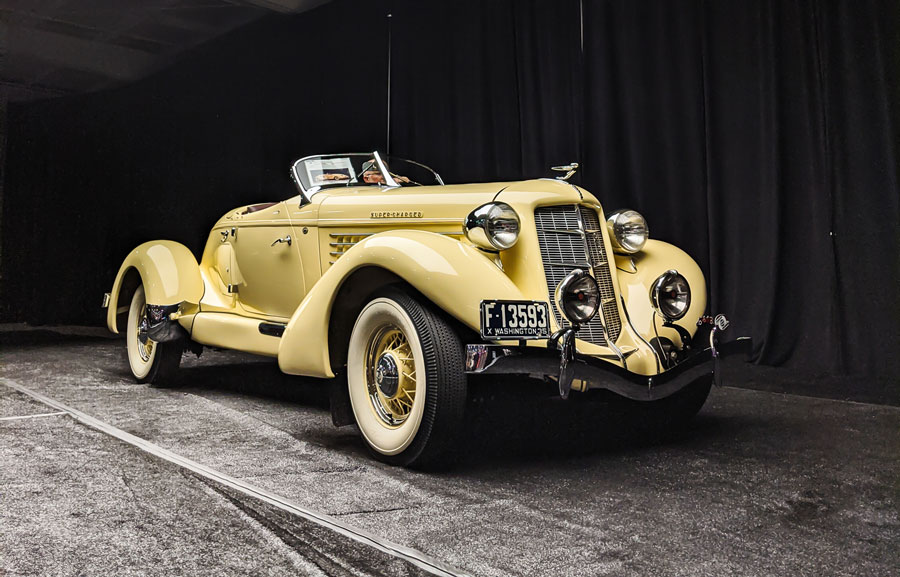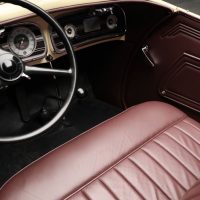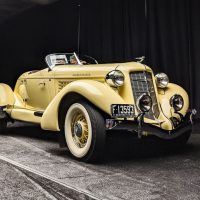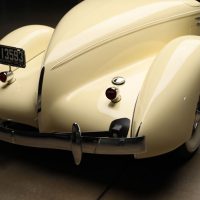- Twice certified Category 1 by the ACD Club
- CCCA Senior and National First Prize winner
- Supercharged “SC” model with Columbia rear axle
- One of the most stunning body styles of any era
- Meticulously restored with original components in the late 1990s
SCM Analysis
Detailing
| Vehicle: | 1935 Auburn 851 SC Boattail Speedster |
| Years Produced: | 1935–36 |
| Number Produced: | 180 |
| SCM Valuation: | $756,000 |
| Tune Up Cost: | $700 |
| Chassis Number Location: | Right frame rail |
| Engine Number Location: | Bellhousing |
| Club Info: | ACD Club, Classic Car Club of America |
| Website: | http://www.acdclub.org |
| Alternatives: | 1930 Packard 734 Boattail Speedster, 1931 Hudson T119 Boattail, 1934 Duesenberg Model J Boattail Speedster |
| Investment Grade: | A |
 This car, Lot 42, sold for $1,072,500, including buyer’s premium, at Worldwide Auctioneers’ Auburn Auction in Auburn, IN, on September 5, 2020.
This car, Lot 42, sold for $1,072,500, including buyer’s premium, at Worldwide Auctioneers’ Auburn Auction in Auburn, IN, on September 5, 2020.
Errett Lobban Cord was a brash but successful 30-year-old car salesman for the Moon Motor Car Company when he was approached by a rather desperate Auburn Automobile Company to become its general manager. He countered with a proposal that allowed him to eventually own the company. He added sizzle to move the extensive unsold inventory by chopping the tops and adding nickel plating along with striking two-tone paint schemes. The 700 unsold Auburns quickly sold at a profit of $500,000. Sales doubled in 1925 and again the following year.
Auburn became the cornerstone of Cord’s burgeoning empire that in time included 150 companies. Among the notables were Checker Cab, Stinson Aircraft and American Aircraft, the precursor to American Airlines.
A beautiful vision
Cord’s vision for Auburn was dramatic styling and exceptional performance along with value pricing. The Auburn Boattail Speedster, introduced in 1928, certainly checked those boxes. It had a raked windshield, cut-down doors, dual sidemounts, hood louvers and, of course, a boattail body. It continued in production, with a couple of lapses, until 1936.
The original design is credited by most sources to Alan Huet Leamy. Some, however, claim that since Leamy did not officially join Cord until April of 1928, the design may have been Count Alexis de Sakhnoffsky’s. The origins of the Speedster likely derive from the 1927 Duesenberg Model X, and regardless of who deserves credit, it was a racy and sporty image builder for Auburn.
(Not) selling speed
Between introduction and its demise, the Speedster was produced in three iterations. The 1928 Speedster was offered as the 8-88 and the 8-115 with 125- and 130-inch wheelbases. Test driver Wade Morton set a one-mile speed record for stock cars of 108.46 miles per hour with a Speedster, which brought people into the showrooms, yet only 226 were sold. Production continued for 1929, but the Speedster was dropped for 1930.
A plaque on the dash of each car attested to its having been driven 100-plus miles per hour by Ab Jenkins, the pioneering top-speed racer. This was, for the most part, a sales gimmick. The plaques were attached during the assembly process and it was later stated that only about one in five were tested. According to Jenkins, many could not break the 100-mph mark.
For the resuscitated 1931 Speedster, Alan Leamy created a stunning new design. It was offered as an Eight and Twelve, with three trim levels. Prices were reduced to under $1,000, but with the country in the grip of the Great Depression, sales stalled. Only 20 were sold in 1933, with leftovers sold the following year.
The Leamy designs were the scapegoat, so Gordon Buehrig was brought over from Duesenberg to give Auburn a facelift, although with a limited budget. He designed a new hood, eliminated the descending beltline and added a massive grille shell. The result was sensational, but Cord himself had lost interest, moving to England as the company was under government investigation on several fronts. His automotive empire was coming to an end, and only 180 Speedsters were produced in the final two years, 1935 and 1936.
Despite the gorgeous design, like all cars, the Speedster had its issues. The front bumpers on the 1934–36 versions have a tendency to fall off. Oil and water leaks were prevalent. The car had a wood frame, and the seams were simply covered with moldings, which invited the wood to rot. It also had a habit of catching fire, so suffice it to say that a limited number of Speedsters survived.
Crispy in Cream
The 1935 Auburn 851 SC Speedster offered by Worldwide was powered by an inline 8-cylinder Lycoming-supercharged engine, with a 3-speed transmission and an optional Columbia 2-speed rear end. It produced 150 horsepower, which was impressive for the era.
The Speedster was part of several prominent Pacific Northwest collections before being restored by ACD expert John Dennis. While in the Dennis stable, the car was frequently shown and garnered numerous CCCA and ACD Club awards. The accuracy of the restoration has been documented twice, once at the local level and then at a national ACD meet. Having been certified Level 1 by the ACD Club attests to the fact that it retains all its original components.
The car is finished in an attractive shade of Cigarette Cream that is complemented by its maroon leather interior. The dash is fitted with the correct 160-mph speedometer and a tachometer. It also has a clock and radio with the antenna hidden under the right running board. It even has its 1935 Washington license plate intact.
While restored a while ago, now it has been properly maintained, and the car is still crisp and stunning. Several 851 and 852 Auburn Speedsters have sold of late, and three-quarters of a million dollars seems to be the number. This one sold for a third again as much, which is to be expected for so fine an example. For a well-documented car that stands head and shoulders above other recent offerings, even in an uncertain market, this should be considered well bought. ♦
(Introductory description courtesy of Worldwide Auctioneers.)



